China's Qing Dynasty
The Qing Dynasty, China's largest and last, ruled from 1644 to 1912. At its end, it had presided over the world's most populous country. Since the 14th Century, the Ming Dynasty had ruled China. During the few centuries of that dynasty's rule, the rulers upgraded the Grand Canal and the Great Wall and ordered the creation of the Forbidden City. Some emperors' reigns were more stable than others. 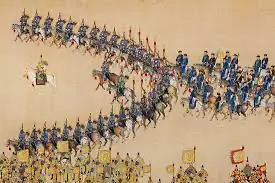
As had happened a few times before, however, widespread famine led to disillusionment with the government and, in this case, uprisings that turned violent. Aiding these were a large influx of Manchus, people from Manchuria, who had gained increasingly in numbers and placements within the Ming state itself. Pressure came from directly within, as a number of units of soldiers turned disappointment at not being shipped supplies into a grievance against their superior officers and rebelled. Li Zicheng, one of those peasant soldiers so disaffected, led a large armed force that took over Beijing, the capital, in May 1644. Rather than submit, the Chongzhen Emperor took his own life. Seeing the writing on the wall, the Ming commander in the north, Wu Sangui, opened the gates of the Great Wall at Shanhai Pass, allowing a large Manchu force to pass through unhindered. The joint enemies of Ming China never quite became allies, and the more well organized Manchus seized control from Li Zicheng and his force. The result was a new dynasty, the Qing. The Manchu people were descendants of the Jurchens who formed the 10th Century Great Jin Dynasty. Originally nomadic, they settled down on farms and embraced other outdoor pursuits. They became highly skilled riders of horses, and it was that horseborne skill, combined with archery prowess, that gave the Manchu invasion forces an advantage over the Ming defenders. 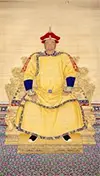
A warlord named Nurhaci (left) united a number of Manchu tribes and, in 1616, declared the Later Jin dynasty. His son and successor, Hong Taiji, was the first to declare a brand new dynasty, the Qing, in 1636, with its capital at Mukden. He took full advantage of the chaos that enveloped the last Ming emperor and paved the way for the first Qing emperor to rule from Beijing, his son Fulin. The successor was just 5 and depended on two uncles, Dorgon and Jirgalang, to act as regents. Officials proclaimed Fulin the Shunzi Emperor. The boy ruler waited seven years to declare himself free of regency. His personal rule lasted a decade, during which his armies strove to complete the conquest of the remaining Ming rebels. He died of smallpox in 1661, when he was 22. It was like father, like son, as succeeding the Shunzi Emperor was his 7-year-old son, Xuanye (who had survived smallpox), who became the Kangxi Emperor. 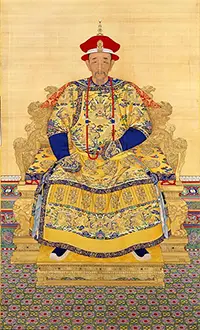
That emperor (right) ruled for 61 years, achieving the longest-ever imperial reign in Chinese history. For eight years, he depended on four regents and his grandmother, the Grand Empress Dowager. He then declared personal rule and set about enhancing his empire's growth and prestige. Not all of the emperor's subjects agreed with his policies. The Qing rulers had come to power through means of military conquest, and supporters of the preceding Ming Dynasty were still prevalent in various parts of the empire. In an attempt to assert his authority firmly, the emperor ordered a number of powerful officials to leave their hereditary domains and go into retirement up north, in Manchuria. The response was the Revolt of the Three Feudatories, and it took imperial forces eight long years to put down that revolt. Two years later, the Kangxi Emperor enjoyed a naval rout of Ming loyalists on Taiwan. The result was a Qing takeover of the island. In the north, Qing forces fought against enemy forces in Mongolia and Russia. The conflict against the latter ended in 1689 with the Treaty of Nerchinsk, China's first with a European power. Against the former, Qing forces deployed a combination of diplomacy, intervention, and war, all resulting in an even greater Chinese presence there. Despite all of that armed conflict, much of China enjoyed a relative peace, allowing the Kangxi Emperor's economic policies to take hold. A reduction in taxes found favor with everyone, and slightly increased interactions with other civilizations filled Chinese coffers. Like many emperors of many previous dynasties, Qing rulers employed an efficient bureaucracy to oil the machinery of government and trade. The Kangxi Emperor achieved this by championing the Confucian values that traditionally appealed to those staffing the most important government posts, including the use of examinations to produce well-functioning staffers. Cultural achievements were part of this emperor's agenda, and the results were the Kangxi Dictionary, a compilation of Chinese characters, and the Quan Tangshi, a compilation of Tang poetry. At the same time, China during much of the Qing Dynasty remained mostly traditional and not at all developing of new technologies such as those being advanced in the Western Industrial Revolution. The Kangxi Emperor, a fan of Western technology, was one exception to this. 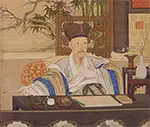
When the Kangxi Emperor died, in 1722, he named his fourth son, Yinzhen, to succeed him. This successor became the Yongzheng Emperor. He and his son and successor, the Qianlong Emperor (left), propelled China to its largest geographical extent, surpassing 5 million square miles. China's influence spread farther and wider, as many neighboring civilizations existed in a tributary capacity, Korea among them. The emperor's reach became over-reach when his armies failed to conquer Burma and Vietnam. A continued isolation and a rise in imperial palace corruption led to a renewed distrust of the government by the people at large. Echoing his grandfather's cultural success, the Qianlong Emperor ordered completed the largest collection of books in Chinese history. Known as the Siku Quanshu, it encompassed more than 36,000 volumes. The Qianlong Emperor died in 1796, after 60 years on the throne. It was during the reign of his son and successor, the Jiaqing Emperor, that serious conflict between China and European powers began. China had made a policy of allowing Christian missionaries to enter the country and set up places of worship. This had been going on for some time as the 19th Century began. Chinese emperors grew weary of such Western influences, however, and eventually ordered a stop to such missionary practices. A series of bad harvests and a number of unsuccessful military expeditions led to a large amount of internal unrest, punctuated by the White Lotus rebellion and the Miao rebellion. The Jiaqing Emperor succeeded at putting down both uprisings, but the cost in loss of life and money was high. 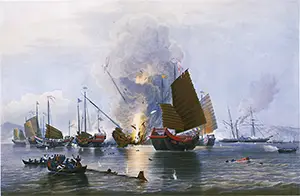
Also high at this time was the amount of opium smoked by Chinese people. Such a practice had begun several centuries before, but the Qing ascension coincided with an explosion in demand for the powerfully addictive opium. Political conflict led to military conflict; and the First Opium War, pitting China against Great Britain, began in 1839. British armies and navies had no trouble defeating the technologically backward Chinese forces. The Daoguang Emperor surrendered in 1842 and agreed to the humiliating Treaty of Nanjing. Among the terms of that treaty were the requirement of the emperor to open a number of large ports to Western trade. As well, China handed over control of Hong Kong to Britain. The Second Opium War, a few years later, had similar results. A new ruler, the Xianfeng Emperor, agreed to the Treaty of Tientsin, which was even more humiliating to China than the earlier treaty had been. For example, China had to write all official documents in English and also had to give British warships right of passage through all of China's rivers. The Chinese government attempted to recoup lost financial power through taxing the population. Frustration with military defeats and with a perceived lack of competitiveness with other nations fueled another large-scale uprising, the Taiping Rebellion. A Utopian hopeful named Hong Xiuquan established a dream of a society known as the Kingdom of Heavenly Peace. Thousands flocked to the ideal and set up a rival capital in Nanjing. The Qing response was brutal and long-lasting. From 1850 to 1864, even as the Second Opium War raged, Qing armies (bolstered by none other than British and French troops) employed all manner of cruel tactics against a decentralized, ill-equipped enemy. Many historians put the body count for this conflict in the tens of millions. The emperor and his armies were victorious in the end but sustained much loss of life; as well, the war devastated the countryside and weakened industry and other elements of infrastructure for many years afterward. China had also fought against Japan for control of the Korean Peninsula. In the Treaty of Shimonoseki, which ended the First Sino-Japanese War, China agreed to give Taiwan and another island, Penghu, over to Japan, as well as renounce all claims of influence in Korea. In addition, China handed over the Liaodong Peninsula, which contained the strategic Port Arthur. 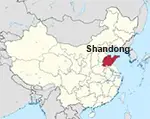
Shandong Province, in the east, was particularly hard hit by flooding and famine in the late 1890s; as a result, many farmers went to cities in search of food. Existing discontent with German missionaries, fueled by an ongoing dispute over one religion's building a church on the site of another's former temple, boiled over into violence; and in the Nov. 1, 1897, Juye Incident, a group of angry Chinese men killed two missionary priests. The German leader, Kaiser Wilhelm II ordered German troops to take over Shandong Province. Seeing this, other Western powers moved to expand their influence within China. France and the United Kingdom expanded their presence in a number of provinces, and Russia obtained a controlling role in all territory north of the Great Wall. In June 1898, the Guangxu Emperor embarked on the Hundred Days' Reform, a program of modernization along the lines of what Japan had done after the Meiji Restoration, with the goal of bringing China on a par economically and militarily with Japan and the West. The Chinese defeats in the Opium Wars and the war with Japan had revealed China's military weakness, especially. 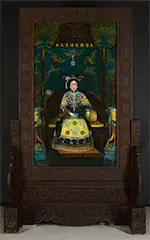
Reactionary forces were still strong in China, however, and many people did not want to change, no matter how much the rest of the world had. One of those resistant to change was the Dowager Empress, known as Cixi. She had assumed a regent's role because the emperor was young. In mid-1898, she seized control of the government and dampened enthusiasm for reform. The result was the Boxer Rebellion. 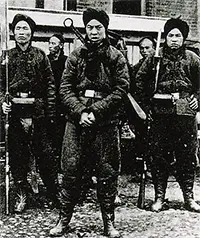
A group of Chinese nationalists who had trained in the martial arts and believed themselves to have special powers organized in the I-ho-ch'uan (Society of Righteous and Harmonious Fists) and attacked people from other countries. Westerners, referring to the martial training methods, called these people Boxers. Many of these Boxers were dispossessed peasants from Shangdong Province. The Boxers as a whole, though, represented areas around the country. They focused their ire not only on foreigners but also on Chinese people who had converted to Christianity, seeing them as having embraced Western ideals. The Boxers originally included the Qing Dynasty in their list of enemies, since the government had embraced so many other nations by way of international treaties. However, the Dowager Empress appealed to the Boxers to join the government in repelling the invading foreigners. They eventually did so. 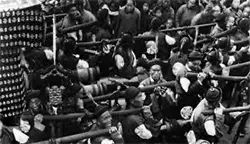
It was too late, as a force of about 20,000 from a coalition of Austria-Hungary, France, Germany, Italy, Japan, Russia, the United Kingdom, and the United States invaded and eventually defeated the Chinese defenders. The Boxer Protocol, signed on Sept. 7, 1901, further weakened an already struggling Qing Dynasty. A mere 10 years later, the dynasty was at an end. The long years of rebellions, natural disasters (including a flood that killed 1 million people), famines (including two of the most devastating in world history), and external conflicts (military and political) had left the country in a severely imperiled state, ripe for one more uprising. That came against the Xuantong Emperor, a 2-year-old boy whose birth name was Puyi. Rebels led by Sun Yat-sen overthrew the empire in 1912 in a relatively bloodless manner and established a presidency-led new government. The Republic of China had its capital at Nanjing. |
|
Social Studies for Kids
copyright 2002–2024
David White




